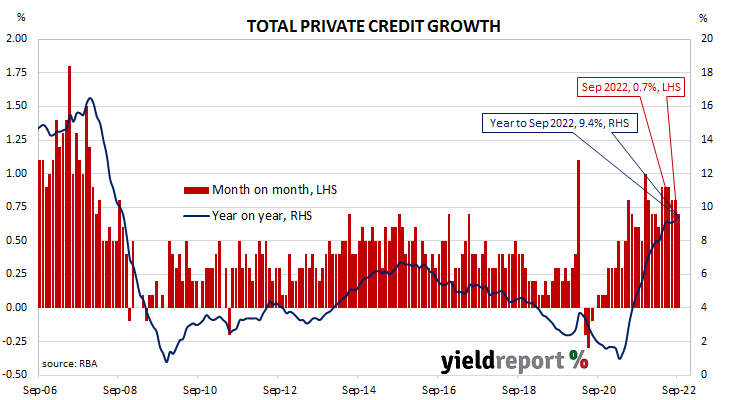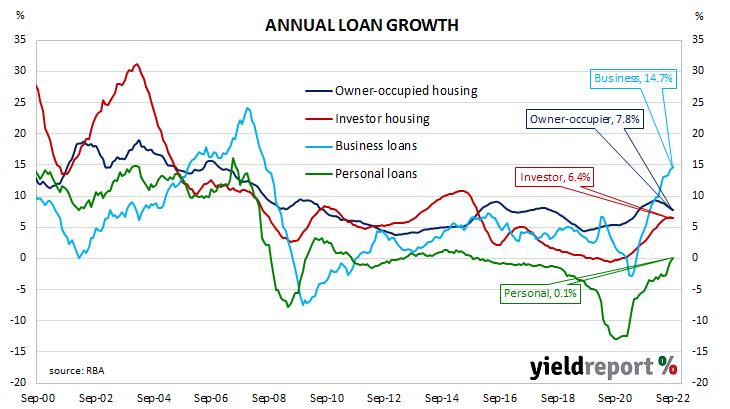Summary: Private sector credit up 0.7% in September, in line with expectations; annual growth rate accelerates from 9.3% to 9.4%; provides further confirmation of anticipated slowing; “business credit growth will cool appreciably” as firms reduce investment in 2023; business loans account for nearly 60% of net growth.
The pace of lending to the non-bank private sector by financial institutions in Australia followed a steady-but-gradual downtrend from late-2015 through to early 2020 before hitting what appears to be a nadir in March 2021. That downtrend ended later in the same year and now annual growth rates are above the peak seen in the previous decade.
According to the latest RBA figures, private sector credit increased by 0.7% in September. The result was in line with expectations but slightly slower than August’s 0.8% rise. On an annual basis, the growth rate accelerated from 9.3% in August to 9.4%.
“The September private sector update provided further confirmation of the anticipated slowing in the face of rapidly rising interest rates,” observe Westpac senior economist Andrew Hanlan.
Commonwealth Government bond yields moved modestly higher on the day. By the close of business, the 3-year ACGB yield had crept up 1bps to 3.34% while 10-year and 20-year yields both finished 2bps higher at 3.77% and 4.10% respectively.
In the cash futures market, expectations regarding future rate rises firmed a touch on average. At the end of the day, contracts implied the cash rate would rise from the current rate of 2.31% to average 2.845% in November and then increase to an average of 3.05% in November. May 2023 contracts implied a 3.82% average cash rate while August 2023 contracts implied 3.945%.
“With the economy set to slow sharply in 2023, impacted by high inflation and rising interest rates, non-mining firms will likely cut equipment investment and business credit growth will cool appreciably,” forecasted Hanlan.
Business lending accounted for nearly 60% of the net growth over the month while owner-occupier lending accounted just over 30%. Investor loans and personal loans both increased modestly.
The traditional driver of overall loan growth, the owner-occupier segment, grew by 0.5% over the month, the same growth rate as in August and July. The sector’s 12-month growth rate slowed again, this time from 8.0% to 7.8%.
Total lending in the business sector increased by 1.3%, up from the 1.2% increase recorded in August. Growth on an annual basis accelerated from 14.1% to 14.7%.
Monthly growth in the investor-lending segment slowed to a halt in early 2018. Shortly into the 2019/20 financial year, monthly growth rates slipped into the red before posting a series of flat or near-flat results until mid-2020. In September, net lending grew by 0.3%, down from August’s revised rate of 0.4%. The 12-month growth rate slowed from 6.6% to 6.4%.
Total personal loans were unchanged in percent terms, down from 0.3% in August, taking the annual growth rate from -0.6% to 0.1%. This category of debt includes fixed-term loans for large personal expenditures, credit cards and other revolving credit facilities.



